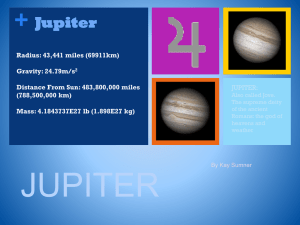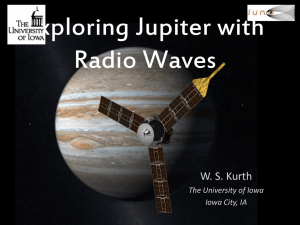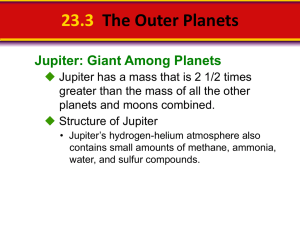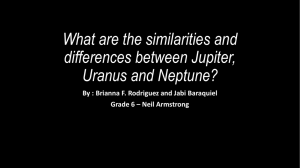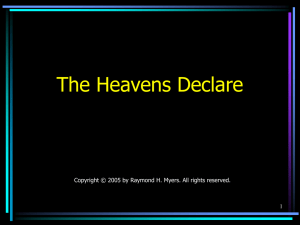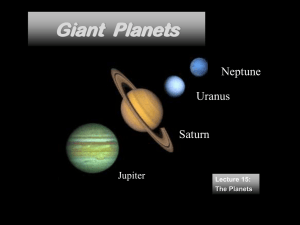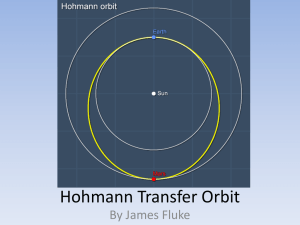Jupiter, the dominant Gas Giant Planet
advertisement
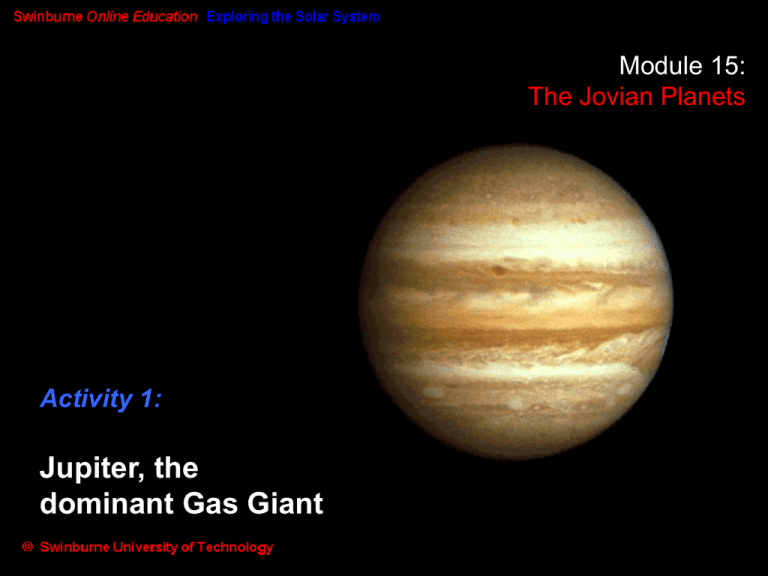
Title Frame Activity 1: Jupiter, the dominant Gas Giant Module 15: The Jovian Planets Summary: In this Activity, we will investigate: (a) why Jupiter is an important planet for study, (b) Jupiter’s vital statistics, (c) properties, (d) space missions to Jupiter, and (e) Comet Shoemaker-Levy 9. Jupiter is the first of four planets categorized as Jovian Gas Giants. Jovian is derived from the Latin name for Jupiter. (a) Why is Jupiter an important planet to study? This image provides some answers … (Earth added to scale) Atmosphere properties Comparisons with Earth Jupiter’s Satellites Long term features such as the Great Red Spot Jupiter-sized planets have been found around other stars Being the Sun’s largest planet, Jupiter might be expected to influence the trajectories of other planets, comets - and spacecraft! And more ... (b) Vital Statistics Jupiter Jupiter’s orbit Approximate values are initially used Earth a further 4.2 AU Sun 150 million km ( = 1 AU - Astronomical Unit ) 1 year ~12 years Different scales for size and distance Jupiter’s size Here is our familiar Earth and Jupiter and its brightest satellites as visible in a small telescope Jupiter’s size … and we’ll revisit this feature - larger than 2 Earths Earth on the same scale as Jupiter 11.2 Earths in equatorial diameter 10.5 Earths pole to pole What might explain this equatorial bulge? Jupiter’s mass The volume of Jupiter would enclose more than 1000 Earths, yet its mass is ‘only’(!) 318 Earths. This suggests that it is not a solid planet. Jupiter’s Rotation A non-rotating planet might be expected to be spherical Jupiter rotates in just 9 hours 50 minutes at its equator at a tilt of 3° to its orbital plane Its large equatorial bulge from the rapid rotation further suggests that Jupiter has a non-solid structure. (Along with the ‘low’ mass mentioned in the last frame.) Yet to unfold: What other factors might contribute to the complex atmospheric patterns we observe on Jupiter? Jupiter’s Structure Let’s dissect Jupiter to see what structure might explain the factors mentioned in the last two frames . . . 1000 km thick atmosphere Liquid Hydrogen Liquid metallic Hydrogen Rocky Core Overall, Jupiter appears to be around 71% hydrogen, 24% helium and about 5% heavier elements Summary to date Orbit - over 5 times further from the Sun than Earth - nearly 12 Earth-years in duration Size - over 11 Earths in equatorial diameter - 10.5 Earths in polar diameter - 318 Earth masses (but over 1000 Earth volumes) Rotates - in 9 hours 50 minutes, tilted by 3° Structure - a small rocky core in liquid Hydrogen with a relatively thin visible atmosphere Overall ~71% hydrogen, ~24% helium, ~5% heavier elements (c) Properties North Jupiter’s visible details Hemispheres: The southern hemisphere (closest to your southern horizon as you view it) is characterised by the Great Red Spot Polar Temperate Regions Tropical Equatorial Markings are called ... belts for the darker bands and zones for the lighter bands plus light (mainly in S) and dark (N) ovals and eddies South So the Great Red Spot is in the N/S? belt/zone southregion? equatorial belt ? and this is the?north tropical zone Jupiter’s Temperature The temperature at Jupiter’s cloud tops is around -110°C Jupiter emits nearly twice the amount of radiation it receives from sunlight. It thus has its own internal heat source. This could arise from: - slow cooling since its original formation - slow gravitational contraction - frictional motion of deep internal material (Unlike Earth) Jupiter has no great variation in temperature from polar to equatorial regions. Motions in Jupiter’s atmosphere Higher west to east winds in Jupiter’s equatorial region makes this region appear to rotate faster (in 9 hours 50 minutes) than the interior and the rest of the planet (9 hours 55 minutes). Winds blowing at different strengths and in different directions cause the swirling eddies at the edges of belts and zones. East Convection currents, from the variation in temperature with depth, lead to zones and belts having different vertical motions. For 50 years, it has generally been thought that belts are regions of falling gas and zones are regions of rising gas. Recent Cassini data now suggests it is the other way around. For more details, see: http://saturn.jpl.nasa.gov/news/press-releases-03/20030306-pr-a.cfm Belts are regions of rising gas, higher pressure Zones are regions of falling gas, lower pressure The convection process is shown in animations in the next slide . . . zones Convective currents The belt and zone pattern is driven by convective currents due to the temperature gradient from Jupiter’s interior. belts increasing temperature Composition of atmosphere Spectroscopic fingerprinting of Jupiter’s upper atmosphere indicates three main layers of clouds: Frozen ammonia crystals Ammonium hydrosulphide crystals Frozen water crystals Normally the crystals in all three layers are white. Apparently temperature differences at different depths, (plus molecules including elements such as sulphur and phosphorus, which can assume many colours under different conditions of temperature and ultraviolet sunlight), produce the many colours seen in Jupiter’s atmosphere. Frozen ammonia crystals Ammonium hydrosulphide crystals Frozen water crystals Colours at different depths are indicated above: brown - deepest, warmest; and red - highest, coolest. The turbulent circulation in Jupiter’s atmosphere reveals the colours at different depths - producing the zones, belts, ovals and eddies. The Great Red Spot Earth to scale The most famous example of Jupiter’s markings is the Great Red Spot, which has persisted for over 300 years. It is an anti-cyclonic storm rotating between opposed winds in ~6 days. Its cooler, higher altitude clouds appear redder than surrounding regions. With 600+ km/hr winds, a turbulent region indeed . . . (d) Space Missions to Jupiter Much of our information about our own planet is from our first hand experience of it. Our knowledge about Jupiter comes from: - photographs - from Earth (ground and orbit) and from spacecraft - spectroscopic information from reflected sunlight - theory - e.g. size, mass and rotation leads to conclusion about internal structure - two additional first hand sources of information: the Galileo spacecraft probe into Jupiter’s atmosphere the 1994 entry of Comet Shoemaker Levy 9 into Jupiter’s atmosphere The Pioneer 10 & 11, Voyager 1 & 2, Galileo and Cassini spacecraft missions are summarised in the next frames . . . The Pioneer space probes Pioneer 10, launched May 1972, passed Jupiter at a distance of 130,000 km in December 1973. It photographed Jupiter and the Great Red Spot, satellites Europa, Ganymede and Callisto, and measured the extent of Jupiter’s radiation belts. Pioneer 11, launched April 1973, passed 43,000 km below Jupiter’s south pole in December 1974, moving on to photograph the Saturnian system from September 1979. Both crafts are heading out of the Solar System in opposite directions. Pioneer 10 was over 12 billion km from Earth in February 2004 (compared with Pluto’s mean distance from Sun of 5.85 billion km). The Voyager spacecrafts Voyager 1, launched September 1977, reached Jupiter in March 1979, closely photographing satellites Callisto, Ganymede, Europa and Io, before approaching 280,000 km from Jupiter. It went on to photograph Saturn (November 1980) before heading out of the Solar System. Voyager 2, launched August 1977, reached Jupiter in July 1979, passing close to satellites Callisto, Ganymede and Europa before its 714,000 km approach to Jupiter. Most of the photos in this Unit are from Voyager 2. It went on to photograph Saturn (August 1981), Uranus (January 1986) and Neptune (August 1989), before heading out of the Solar System. The Voyager flight paths Note the use of gravity assists (most notably at Saturn) to deflect and assist craft on to the next target. Gravity assists are evident in the Galileo spacecraft flight path, 2 frames on . . . Pioneer and Voyager ‘exit from Solar System’ The Galileo Spacecraft Features: Launch inwards toward Venus Gravity assists at Venus and Earth(2) Close-up images of two asteroids Asteroid Ida and its orbiting 1km sized companion Dactyl Arrived 1995 Images of Comet SL-9 impact out of sight from Earth (see later frame) Descent of probe from Galileo (see next frame) Probe descent from Galileo A probe separated from the Galileo spacecraft and descended to its destruction through Jupiter’s atmosphere. In the next diagram, heights and pressures are given relative to a level where the pressure is the same as an Earth surface pressure of 1000 millibars (1 bar): The Galileo Mission The separation and descent of the Probe and insertion of the Galileo spacecraft into orbit around Jupiter. Findings: • Anticipated atmospheric conditions (temperature, pressure etc) were confirmed • The general cloud layer model was confirmed although the lower water clouds were absent (or free on the day!) • The Hydrogen/Helium proportions were confirmed • Heavier elements, including C,N,S, were detected. This diagram shows Galileo’s 11 orbits amongst the satellites of Jupiter. Many detailed photographs and information on the structure of natural satellites were obtained by Galileo (covered later in the Unit Satellites & Rings of the Jovian Planets) The Galileo mission ended on 21 September 2003. Galileo’s propellant was almost depleted and the spacecraft was put in a collision course with Jupiter to avoid an impact with the satellite Europa (which is thought to be one of the best candidates for hosting life). The Cassini Orbiter En route to Saturn, the Cassini orbiter did a Jupiter flyby in December 2000 as part of its “VVEJGA trajectory” (VenusVenus-Earth-Jupiter Gravity Assist). Simultaneous observations were made with Galileo, Cassini and HST to return to highest ever resolution images of the Jupiter. True colour Cassini mosaic made from 27 images with a 60km resolution. Taken on 29 December 2000 during closest approach (at a distance of ~10 million km). (e) Comet Shoemaker-Levy 9 Carolyn and Eugene Shoemaker and David Levy discovered a comet in 1993 which appeared as a ‘string of pearls’. Its orbit was calculated to be about Jupiter, not about the Sun. Jupiter had captured the comet on its entry to the inner Solar System and Jupiter’s tidal forces had broken the comet into a number of fragments. Furthermore, calculations showed that on its next orbit it would impact with Jupiter in July 1994. A year after its discovery the Hubble Space Telescope showed the many fragments of Comet SL9, which were named ‘A’ to ‘W’ Months ahead of the impact, the mathematics leading to this artist’s portrayal of the impact site - just out of view from Earth - proved accurate to within minutes Comet SL-9 Impact sites As Jupiter rotated (left to right in each of the above images) impact sites progressively came into view a few minutes after the impact behind lower-left of Jupiter This sequence (from bottom to top) show an impact followed by the changing appearance of its scattered material in Jupiter’s turbulent atmosphere (together with a previous impact site rotating into view) [Hubble Space Telescope images from Earth-orbit] Comet SL9 Impacts - other images A small sample from the hundreds of images obtained . . . An infrared image from the MSSSO 2.3m telescope showing the actual K fragment fireball and the stillwarm remains of three other sites Though launched before SL-9’s discovery, the Galileo spacecraft was uniquely placed for a direct view of the impact site, as this sequence shows Hubble Space Telescope ultraviolet image showing the debris in the southern hemisphere (and Io in the north), labelled by fragment letters. Outcomes from Comet SL-9 It provided further evidence of Jupiter’s role in affecting trajectories of Solar System bodies. It provided a great example of the power of mathematical orbit calculation in predicting the precise times of the fragment impacts. Most telescopes (professional and amateur; orbiting Earth and en-route to Jupiter) gave some time to observing impacts in many wavelengths - e.g. UV, visible, IR etc. and their imaging ability was successfully tested and used. SL-9’s direct impacts provided further information on the nature of Jupiter’s atmosphere - wind speeds and directions, density etc. Spectroscopic examination of the impact debris had the potential for information about the composition of Jupiter’s atmosphere - what produces its many colours, for example. Sulphur was detected but work continues to separate what might have been from Jupiter and what from the comet fragments! A final contemplation This image superimposes, to the same scale, one of the Comet SL-9 impact sites with our own planet. Two Hollywood movies have (since SL-9) used the theme of a potential comet or asteroid impact with Earth. Whether an Earth-approaching object could be destroyed or diverted is a question for discussion. To at least maintain observations and information on potential Near Earth Objects would seem both wise and, like SL-9, good fields for scientific observation and research. In the next Activity we will look at the other Jovian gas giant planets - Saturn, Uranus and Neptune. Image Credits NASA: http://www.nasa.gov Indexed status of all NASA spacecraft http://www.hq.nasa.gov/office/oss/missions/index.htm Hubble Space Telescope images indexed by subject http://oposite.stsci.edu/pubinfo/subject.html Cassini image of Jupiter http://photojournal.jpl.nasa.gov/catalog/PIA04866 Comet Shoemaker-Levy 9 Collision with Jupiter http://www.jpl.nasa.gov/sl9/sl9.html View of Australia http://nssdc.gsfc.nasa.gov/image/planetary/earth/gal_australia.jpg Now return to the Module 15 home page, and read more about Jupiter in the Textbook Readings. Hit the Esc key (escape) to return to the Module 15 Home Page
